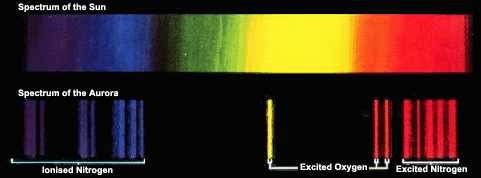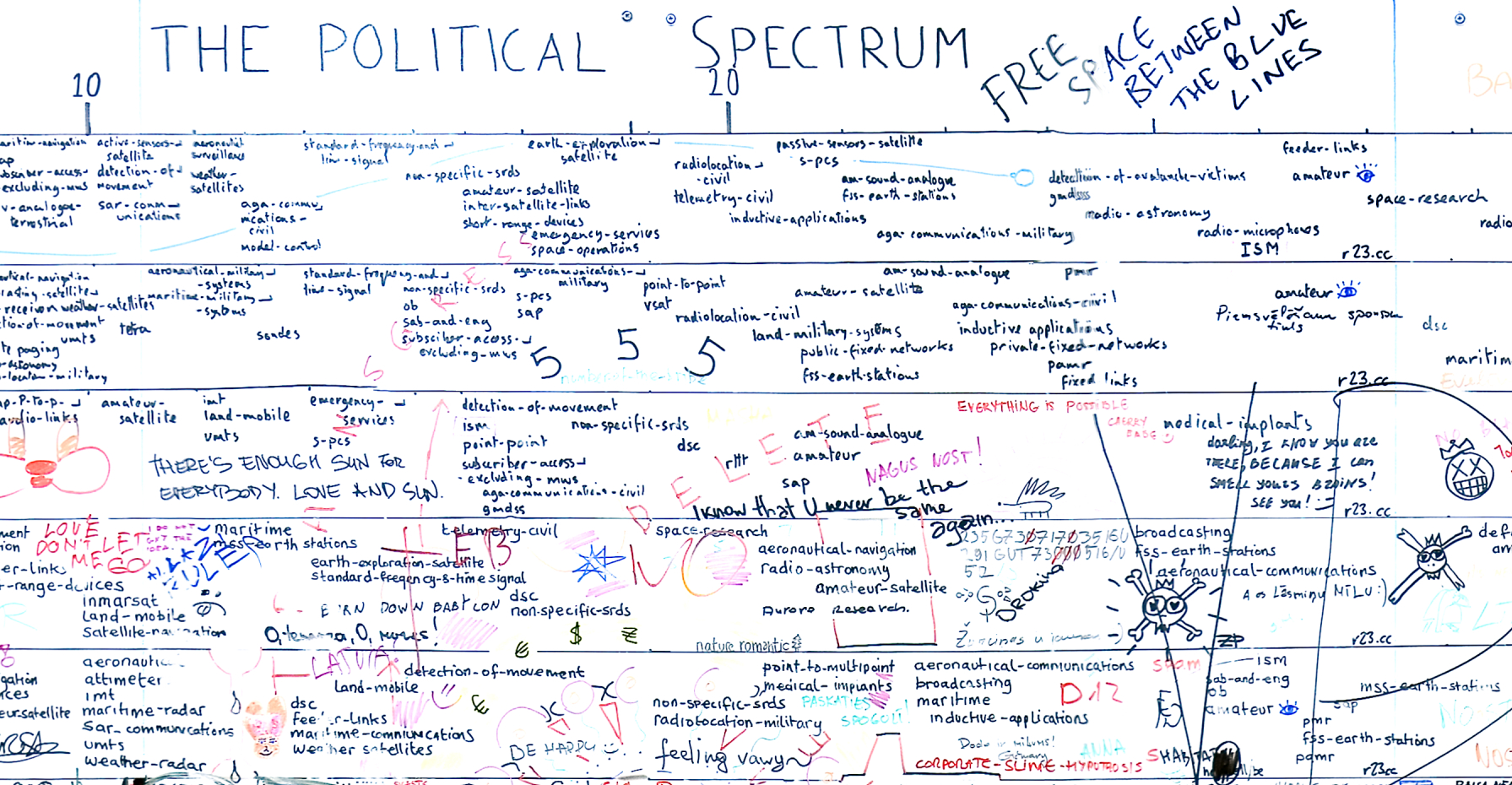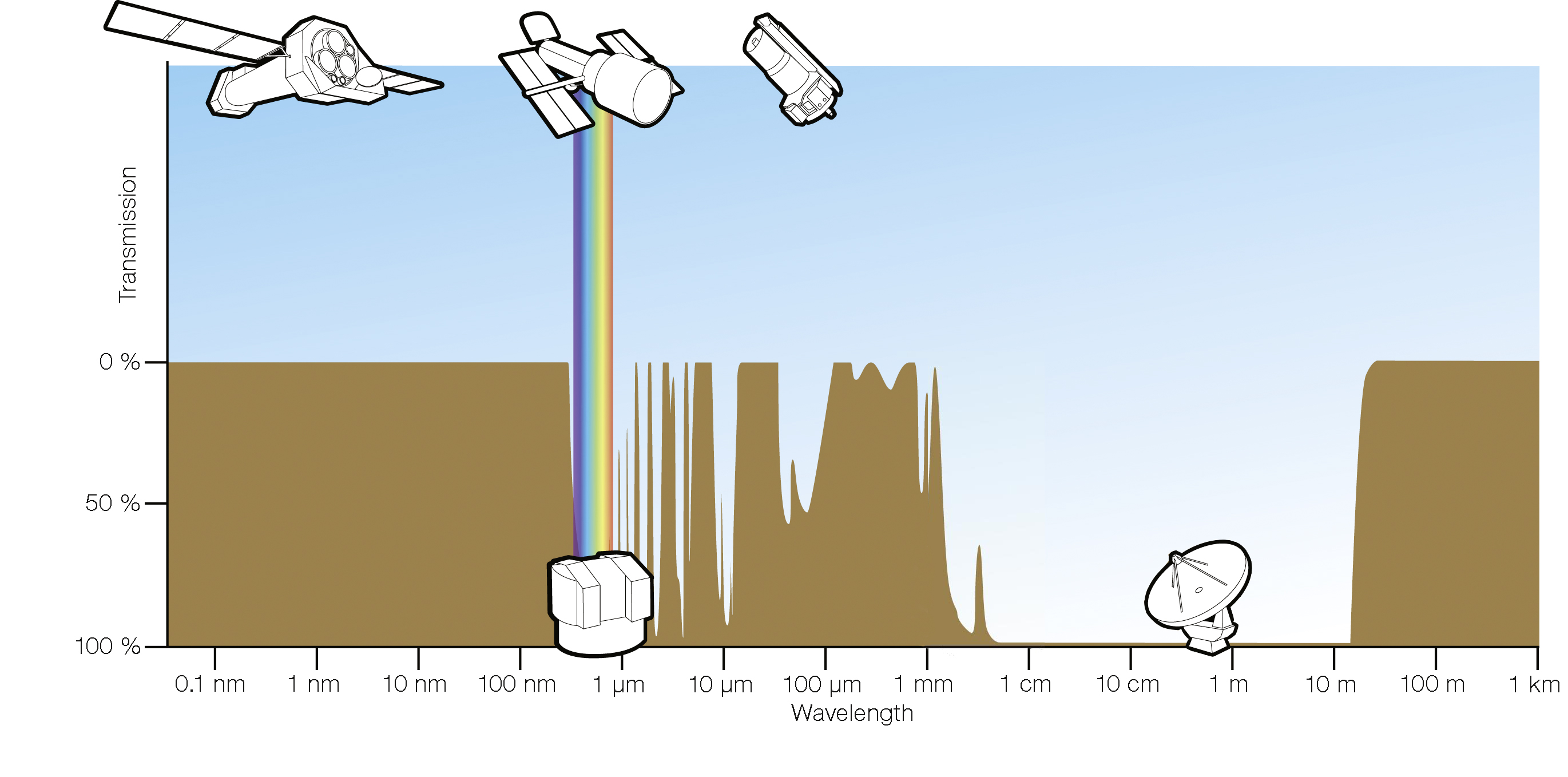Colours,
Communication,
Commons

Auroral colours are from forbidden transitions, transitions or mechanisms in spectroscopy that have minimal or close to no probability of occurring on Earth. Spectroscopy analyses light and measures emitted or absorbed wavelengths to determine the substances emitting or absorbing light. Spectral measurements of aurora were first taken in 1866-67 (by Swedish physicist Ångström), and showed that aurora produced a line spectrum – specific bands of colour – and not a continuous blend of hues. This established that, rather than reflecting light from the sun aurora shone with its own light. Forbidden transitions have only been observed in extremely low-density gases and plasmas in outer space or the upper atmosphere. Therefore the colours did not match any known element, and the identified lines were attributed names like Aurorium and Geocoronium (see Naming).
The atoms and molecules emitting the auroral light were later (1925) recognised as oxygen and nitrogen. Green is the most common colour. Red, purple, pink and blue are generally to be seen during bigger solar storms. Other gases in the atmosphere (such as hydrogen and helium) also become excited and emit light. While these wavelengths are outside of the range of human vision, photographic film and digital cameras often record this broader range of blue and purple hues (P for Posthuman perception). Another reason why we see more green aurora than red and blue is that the human eye is more sensitive to green, particularly at night when eyes are sensitive to low-intensity light only in black and white. This is also why witnesses often report white auroras.

J. Rand Capron, Auroræ: Their Characters and Spectra, 1879.
// Communication, Commons
![]()
The auroral colours are visible manifestations of a much broader electromagnetic spectrum, including radio waves, microwaves, gamma rays and x-rays. The ionosphere – an electrically active region of the upper atmosphere that acts as a natural buffer zone bouncing back electronic signals from the earth – played a crucial role in revealing the existence of this spectrum, notably what we call the airwaves or the radio frequencies, and also came to play a critical role in establishing modern long-distance communication. Even so, unlike the science of colours driven by romantic curiosity and enlightenment, much of what we know about the electromagnetic spectrum as well as its spaces of propagation, is achieved through the intrinsic entanglements of science, militarisation and commercialisation. Starting with transatlantic wireless radio, the electromagnetic spectrum has become the medium of the information age and the conduit of global communication and economy. This has positioned Earth’s electromagnetosphere – a life-support system central for the maintenance of life as we know it (see Ecology) – as an invisible resource to be managed and regulated, colonised and exploited, initially for military purposes, state-control and policing, and increasingly for commercial profit. As a result, most of the airwaves useful for telecommunications are exclusively licensed, legally supervised and their use is highly sanctioned; although being a cosmic common, its ‘improper’ use can be treated as theft or an act of terrorism.
Looking at the historical processes of the neoliberal enclosure of the electromagnetic domain, historian Edward D. Melillo highlights its double invisibility — the aggressive regimes of its privatisation and exploitation are as invisible as the electromagnetosphere itself. Treating the process of ‘making visible’ as a dual task — of rendering electromagnetic phenomena and the processes of their exploitation visible and knowable — is critical because it provides the opportunity to recast the electromagnetic commons as a possible space for fostering ‘freedoms other than exploitative agency’ (Note 1).
![]()
Different from other ‘resources’ the principal use of spectrum is the act of sharing (or retaining) information between transmitter and receiver. Looking beyond the exploitative operations of neoliberalism and the militarisation of electromagnetic fields that have sought to violently transform the spectrum into “a hierarchical, homogenised space of control – for the realisation of the neoliberal mantra, “stabilize, privatize, and liberalize” we may instead revisit Vandana Shiva's reading of the early modern concept of ‘resource’ as a notion comprising respect, responsibility, reciprocity and care (Note 2). Communication systems are indeed fundamental and inherently valuable resources for society and for cultural institution of democracy. Discussing his collaborative artwork The Political Spectrum artist Julian Priest envisions the airwaves as “the possible space of any given electromagnetic interaction … an infinitely re-writable space, Tabula Rasa, to be inscribed temporarily with our communications, structured with our social structures, to be re-used, shared” (Note 3). Resonating with this, Sophie Dyer’s and Richard Thanki’s ‘Installation guide for autonomous communication’ pragmatically highlights the existence of the 2.4GHz and 5GHz bands, which remain exempt to legislative licensing and therefor can be accessed and used indiscriminately (Note 4). Currently vast new portions of the electromagnetic spectrum, including millimeter waves (30-300GHz) and terahertz waves (300GHz - 3THz) are being auctioned off for whatever next-generation consumer devices. How can we responsibly consider and care for these electromagnetic commons set to move us towards the cognitive network of the internet of senses, promoting distributed AI and connectivity of everything?
![]()
Note 1: E.D., Mellilo, Spectral Frequencies: Neoliberal Enclosures of the Electromagnetic Commons. Radical History Review, no. 112 (Winter 2012): 147-61. https://ro.ecu.edu.au/theses_hons/1439/
Note 2: V. Shiva, Resources, in The Development Dictionary. A Guide to Knowledge as Power. Edited by Wolfgang Sachs, 2nd ed. 2010.
Note 3: J. Priest, The Visual Spectrum, 2010, https://julianpriest.org/texts/the-visual-spectrum/
Note 4: Dyer S. and Thanki R, https://www.academia.edu/37607643/A_Z_or_introduction_to_an_electromagnetic_commons

U.S. Frequency Allocation Chart, National Telecommunications and Information Administration October 2003.
The auroral colours are visible manifestations of a much broader electromagnetic spectrum, including radio waves, microwaves, gamma rays and x-rays. The ionosphere – an electrically active region of the upper atmosphere that acts as a natural buffer zone bouncing back electronic signals from the earth – played a crucial role in revealing the existence of this spectrum, notably what we call the airwaves or the radio frequencies, and also came to play a critical role in establishing modern long-distance communication. Even so, unlike the science of colours driven by romantic curiosity and enlightenment, much of what we know about the electromagnetic spectrum as well as its spaces of propagation, is achieved through the intrinsic entanglements of science, militarisation and commercialisation. Starting with transatlantic wireless radio, the electromagnetic spectrum has become the medium of the information age and the conduit of global communication and economy. This has positioned Earth’s electromagnetosphere – a life-support system central for the maintenance of life as we know it (see Ecology) – as an invisible resource to be managed and regulated, colonised and exploited, initially for military purposes, state-control and policing, and increasingly for commercial profit. As a result, most of the airwaves useful for telecommunications are exclusively licensed, legally supervised and their use is highly sanctioned; although being a cosmic common, its ‘improper’ use can be treated as theft or an act of terrorism.
Looking at the historical processes of the neoliberal enclosure of the electromagnetic domain, historian Edward D. Melillo highlights its double invisibility — the aggressive regimes of its privatisation and exploitation are as invisible as the electromagnetosphere itself. Treating the process of ‘making visible’ as a dual task — of rendering electromagnetic phenomena and the processes of their exploitation visible and knowable — is critical because it provides the opportunity to recast the electromagnetic commons as a possible space for fostering ‘freedoms other than exploitative agency’ (Note 1).

Julian Priest, The Political Spectrum, Dry Erase Marker on Whiteboard 5m x 5ft, 2006. http://informal.org.uk/project/thepoliticalspectrum/
Different from other ‘resources’ the principal use of spectrum is the act of sharing (or retaining) information between transmitter and receiver. Looking beyond the exploitative operations of neoliberalism and the militarisation of electromagnetic fields that have sought to violently transform the spectrum into “a hierarchical, homogenised space of control – for the realisation of the neoliberal mantra, “stabilize, privatize, and liberalize” we may instead revisit Vandana Shiva's reading of the early modern concept of ‘resource’ as a notion comprising respect, responsibility, reciprocity and care (Note 2). Communication systems are indeed fundamental and inherently valuable resources for society and for cultural institution of democracy. Discussing his collaborative artwork The Political Spectrum artist Julian Priest envisions the airwaves as “the possible space of any given electromagnetic interaction … an infinitely re-writable space, Tabula Rasa, to be inscribed temporarily with our communications, structured with our social structures, to be re-used, shared” (Note 3). Resonating with this, Sophie Dyer’s and Richard Thanki’s ‘Installation guide for autonomous communication’ pragmatically highlights the existence of the 2.4GHz and 5GHz bands, which remain exempt to legislative licensing and therefor can be accessed and used indiscriminately (Note 4). Currently vast new portions of the electromagnetic spectrum, including millimeter waves (30-300GHz) and terahertz waves (300GHz - 3THz) are being auctioned off for whatever next-generation consumer devices. How can we responsibly consider and care for these electromagnetic commons set to move us towards the cognitive network of the internet of senses, promoting distributed AI and connectivity of everything?

The diagram shows how transparent the atmosphere is at given wavelengths; the principal atmospheric windows are the optical window, the radio window and several narrow infrared windows. ESA/Hubble (F. Granato) 2010.
Note 1: E.D., Mellilo, Spectral Frequencies: Neoliberal Enclosures of the Electromagnetic Commons. Radical History Review, no. 112 (Winter 2012): 147-61. https://ro.ecu.edu.au/theses_hons/1439/
Note 2: V. Shiva, Resources, in The Development Dictionary. A Guide to Knowledge as Power. Edited by Wolfgang Sachs, 2nd ed. 2010.
Note 3: J. Priest, The Visual Spectrum, 2010, https://julianpriest.org/texts/the-visual-spectrum/
Note 4: Dyer S. and Thanki R, https://www.academia.edu/37607643/A_Z_or_introduction_to_an_electromagnetic_commons